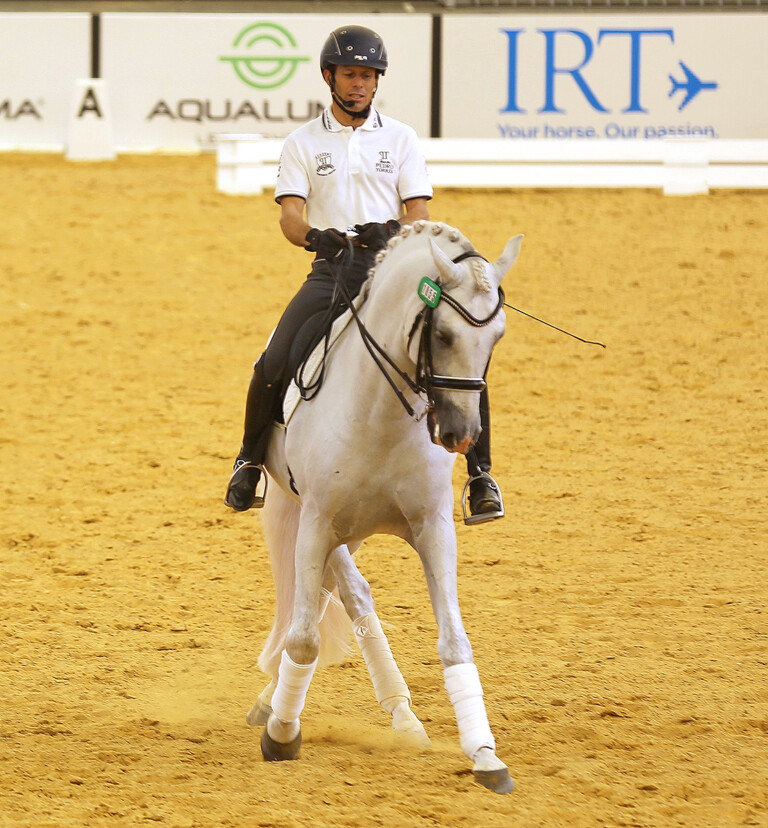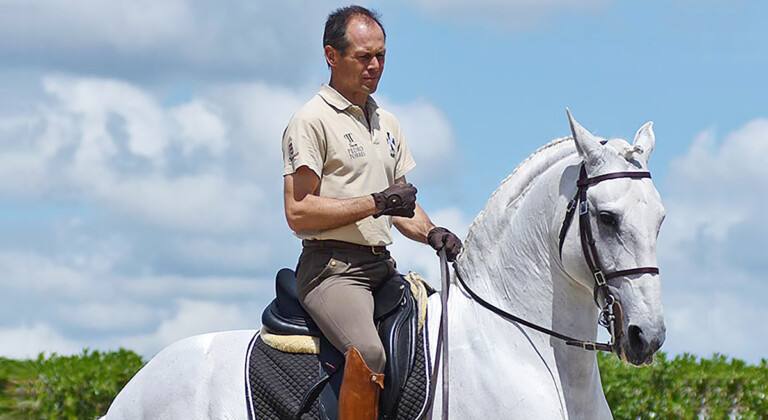Pedro Torres is a multiple World and European Champion in Working Equitation, an FEI-ranked Dressage Rider, and at Equitana recently.
It did not take the capacity crowd in the Aqualuma arena at Equitana long to see that Pedro Torres is a truly exceptional and compassionate horse trainer. He likens riding and training horses to the relationship a person would have with a dance partner, saying:
You both have to be listening to the same music, and when you’re learning the steps you have to go slow!
While this Portuguese star is a multiple World and European Champion in Working Equitation, and has been largely responsible for the phenomenal uptake of WE, he has represented Portugal at the 2007 European Dressage Championships, alongside fellow Portuguese School of Equestrian Art graduates Daniel and Carlos Pinto.
Pedro told us that he has great admiration for the style and achievements of UK champion Carl Hester, and has often taken advice from five-time Olympian Kyra Kyrklund and her partner Richard White, who have both helped Pedro achieve international success at CDI2* and 3* Grand Prix, which has given him a Dressage ranking with the FEI.
These days Pedro runs his own training yard and rides up to 18 horses a day. He has two very talented dressage prospects in his stable, the Lusitanos Ahoto and Csar, but has no ambitions to qualify for the next Olympic Games. My riding goals are simple, he said. What I want to do is ride better, understand the horses better and find better techniques.

At his Master Class Pedro explained that he would be working with five horses and that he had met the horses in an earlier familiarisation session.
The first horse in was the elegant imported gelding Yarramee Fonzie, owned by Sharyn McCombe and presented by Justine Greer. Pedro explained that following on from their previous meeting, he would aim to improve the horse’s lateral responses and uphill tendency. He mounted calmly and did not ask much in the first instance.
Energy is like water and you receive it, he explained, The hind legs produce this water and it comes across the back until there is enough to make it come to the hands. When you receive the energy in your hands, this is called contact. Our aim is to make more water to catch in our hands.
Pedro likened riding a horse for the first time to meeting a friend. I will sit and feel the movement, he said. It is like when you meet a friend, you are gentle and wait to feel a reaction. After our first introduction, I analyse him, step by step, and use almost nothing in my hands. This horse is very nicely taught . He feels very nice, I try to relax him, I hold him a little to give him support, because he is only four.
Pedro explained that with a four-year-old horse, he opens his outside rein when turning, to allow the shoulder to move across and he uses the corners to prepare for the canter. The outside leg asks for canter (or gallop as he calls it) and the inside leg to indicate the trot, to help the horse become light.
The next combination was Para Equestrian Emma Booth who rode Kirby Park Joy. Emma was a successful eventer before an accident left her paraplegic. She explained that she gets frustrated because she cannot achieve what she once did, and this has prompted her to find other ways to ride horses. Pedro asked Emma to slow down and get her horse more relaxed. I want you very light in your hands, I want more relaxation. When he is slower, he has more expression, he explained to her. I like to see the harmony and balance, this is an opportunity to lighten your hands. Pedro did not ride Emma’s horse; instead he worked with her to achieve a more tactful and light seat and rein aids, and then used preparation to improve the dressage movements. At the end of Emma’s session the pair gave some lovely balance sequence flying changes all done from seat and light hand aids. Perfection!
Next up was Jessica Greelish riding the lovely18-hand gelding Good Time, owned by Victorian, Keryn Connors. After mounting Pedro said, He is a big impressive horse, light in the contact. It is difficult for horses to work like this. It is not a normal environment, he is a little bit tense, and so I touch him in a different way. I introduce myself and keep my legs very soft. I bend him one way and then to the other, I must relax his muscles in order to use his skeleton, the touch is very important. I don’t fight with the horse I learn the feel. I spent hours and hours with my eyes closed and realised that I do not need to be strong with my hands, I only use ONE rein and reins OR legs. I go really, really slow with him you have to learn to dance and when you start, you go slowly to get to know the rhythm.
Pedro worked on small segments of the more advanced movements and prefaced each exercise with the same message. Pedro used the canter on two tracks to free the outside shoulder and added that taking an outside bend was a good exercise to free the inside shoulder. We have to find solutions, he said. This beautiful horse finished the session with Pedro by showing some lovely soft sequence changes in a state of perfect harmony with his rider.
Next out was Clair Arnold riding Dolcima, a mare she has trained from Novice through to Prix St George. Dolcima (Dolly) was very tense and first of all Pedro told Clair to smile.
After mounting Clair’s horse, Pedro said again what a tense environment the huge arena and crowd was for a horse. I have to be very careful with her and use movements like asking her for quarters in and then quarters out, step by step as it helps to take the pressure away. It is very important that the horse gets positive relaxed vibrations from the rider. She has to know that it’s time to slow down. I would do more bending, but it is very hard to have bend when there is so much tension.
At this point in Pedro’s demonstration on Dolly, it was difficult to imagine that he would achieve relaxation and softness, but the patient exercises helped to relax the horse’s back, and Pedro added that little circles can also help reduce tension.
It all added up to a breakthrough where she started to stretch her neck which in turn softened her back.
We must think about how we would want to be touched, rough handling makes horses tense and strong as a way of protecting themselves.
Pedro only worked with what Dolly offered and accepted, and his soft approach allowed the relaxation and calm necessary to show some more advanced work.
We will see if she understands my signals – she is a really fantastic horse, he said, as the pair started to dance their way though the sequence changes to two times. His finale was a number of one times with a relaxed horse, at ease with her rider and environment. The change from very tense and afraid to softness and compliance made this a most interesting learning opportunity for us all.
The final horse in Pedro’s Masterclass was the PRE (Spanish) stallion Istan de Azuel (Imp Ned) and owned by Kerrie Massey. It was a treat to see Pedro riding the type of horse that he usually rides. As he took over from trainer Heather Currie he told us: I chose this horse because he shows me very nice things, but we want him to improve in the piaffe. He has more movement in the front legs and not so much with the hind, These are very elastic horses, they are very flexible but weak, so we need to make specific gymnastic exercises to make their back strong. I am now trying to bring the horse’s neck down, we want to get the belly up and make the back soft. Slow, slow, I put weight into the back legs and stretch the horse’s back. From a collected walk we try a big pirouette them to halt and relax.

The horse stepped out and then did a couple of confused steps. Do not punish your horse, Pedros said. It shows that he is learning to find his legs, but they don’t yet have enough coordination.
We try and try and try to find the best solution. I also try to have the best possible connection of the horse’s hind legs to the contact. I am feeling a different rhythm in the back legs to the front legs because they are elastic and want to go fast. I start off very slow, we want to teach him to dance and at first we have to count, 1,2,3, now I start to get the same rhythm with the front and back legs.
Pedro worked on exercises to free the horse’s shoulders and this lovely measured patient work gave very clear improvements.
In the gallop (our canter) he follows me and I have his head a little down to keep his back up. I slow down just with my body, the horse really engages and sits, feel the rhythm, wait. I check my position, shoulders back!
When the horse is soft and in rhythm, I can try a pirouette. It is good when they have initiative, but they must be relaxed. Now he listens and we will do some changes. Count 1,2,3 and change. Good! The energy is coming from the quarters, I love it, and he is a nice guy! He did very well and is relaxed, nice to my leg.
Now we will make something nice – when the music is ready, let’s dance!
Pedro Torres and Istan de Azuel performed a thrilling freestyle to music with all of the elements of Grand Prix dressage and the joy of movement was a fitting finale for a wonderful four hours with a truly enlightening master of equestrian art. Thank-you Equitana, for giving us all a wonderful experience.
Story and pictures by Berni Saunders, FEI Rider, A Level Judge and equestrian event reporter.




